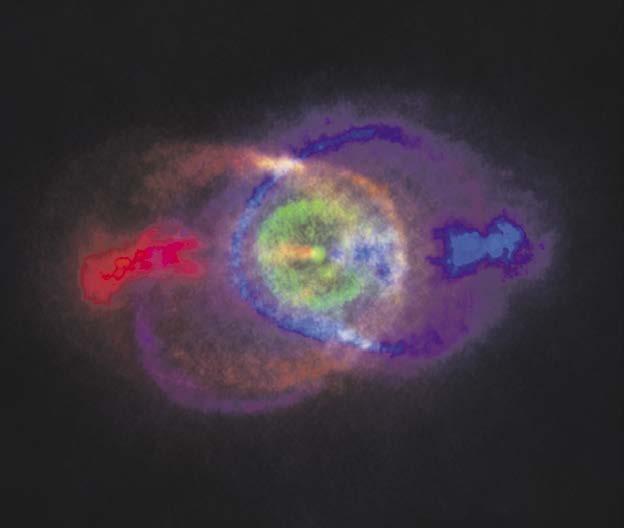
4 minute read
Environmental law requires collaboration
New sides to Astrid Lindgren n Literary scholar Malin Nauwerck has been running the “Astrid Lindgren Code” project since the beginning of the year, in which she runs efforts to decipher the notebooks left behind by the author.
“Astrid Lindgren’s original manuscripts open up a previously unknown dimension of her authorship,” explains Nauwerck. “The manuscripts have long been seen as key to making new progress in research relating to Lindgren. The fact that no one has taken them on before can be explained by the fact that Lindgren wrote her texts in shorthand and thus there was a well established view that her stenography would be almost impossible to decode." PHOTO: SVENSKA BARNBOKSINSTITUTET
Investment in advanced research equipment n To succeed in future research challenges, instruments and machines that have not yet been developed are needed. Uppsala University is investing SEK 80 million to make the FREIA laboratory a lasting national technology environment that can continue to develop accelerators and instrumentation for the large international research infrastructures.

Game offers vaccination against fake news n The game Bad News, which aims to make gamers better at uncovering fake news, works well, according to a new study. The results also show that the gamers maintain confidence in true news.
“Those who play Bad News become much better at uncovering fake news and disinformation linked to fake accounts, conspiracy theories and smear campaigns against investigative journalists,” explains Thomas Nygren, Senior Lecturer at the Department of Education.
RESEARCH Super telescope reveals galactic battle
A long time ago in a galaxy far, far away, two stars met in a battle for survival. The light produced by that confrontation is now reach ing our planet, just in time for astronomers at Uppsala University to document the event in imageform using new technology.
Using the Alma super telescope, astronomers have succeeded in depicting the clash between one of the Milky Way’s smaller stars and a red giant – a star whose supply of hydrogen is exhausted and that is growing far beyond its original size as it dies. During the confrontation that took place around 700 years ago, the smaller star was moving in a spiral formation towards the core of the bigger star, causing the latter to shed layers of gas and thus expose its core.
“For four decades we have been picking up energy signals indicating that something is under way in the area we assess to be some three-thousand light years away. Using new technology, we can finally document the events in image-form and the material to which we now have access is of very high quality,” explains Sofia Ramstedt of the Department of Physics and Astronomy.
THE CONFRONTATION BETWEEN THE two stars is a protracted process. The researchThe depicted confrontation took place in the Centaurus star formation in the southern sky.

ers are already following several similar developments in space, but this is the first time a confrontation has been captured in an image. The results add a vital piece of the puzzle to our knowledge. “We know that stars lose their outer layers during the death process, leaving behind a white dwarf. However, we are not able to say why or exactly how this happens. The images we are now getting are revealing a transition phase between previously studied stages. All in all this offers significant information about the fate awaiting our own sun, but also the Universe as a whole,” adds Ramstedt. Magnus Alsne
4 QUESTIONS TO YAFFA EPSTEIN, Researcher at the Department of Law. Collaboration required
1You are researching how scientific terms are used in environmental law, together with ecologists from SLU. What will your project entail? “Initially we will look at how to combine legal and ecological expertise to translate certain terms, all of which are linked to the natural sciences and are used in several EU directives relating to environmental protection. Then we hope to construct a general theory on how legal experts and natural scientists can work together to interpret these types of terms in law or, even more broadly, how to communicate across scientific disciplines.” 2 Why is this a particular problem in environmental law? “Because environmental law is about managing the human relationship with nature, so almost every environmental law is going to involve the non-human, which has to be understood through scientific intermediaries. One example is that species populations should be viable according to the EU Habitats Directive, but the term viable isn’t defined further in that law. This means you have to talk to a scientist about what makes a species population viable, which isn’t a clear cut question for a scientist either, as it involves the question of how high an extinction risk we want to accept. Nobody really has a monopoly on defining viability.” 3 How, then, can lawyers better communicate with natural scientists and experts? “Talking past each other is a common issue in interdisciplinary collaboration. What I’m working on is a method to argue with each other constructively rather than to ignore communication problems.”

Yaffa Epstein, Researcher at the Department of Law.
4Do the laws need to be rewritten to be clear and specific enough? “No, a law can’t cover every situation or define everything. But it is important to be conscientious when interpreting the law requires scientific input or value judgements.” Annica Hulth










